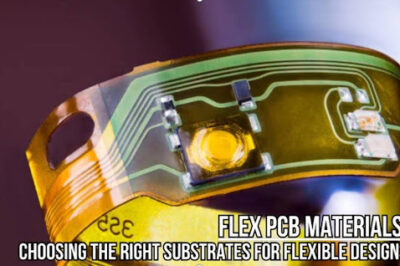In the ever-evolving world of electronics, flexibility isn’t just a feature; it is now a necessity. Flex PCBs have changed how we design and manufacture electronics as they have opened the doors to creative and innovative electronic designs. However, there is one recurring decision that flex PCB manufacturers need to make – and that is selecting the right materials and the right substrate.
In this article, we’ll explore the type of substrates and key considerations that a flex PCB manufacturer needs to make to ensure that they choose the correct substrate to facilitate flexible designs.
The potential selection of flex PCB materials of substrate
In this section, we’ll be discussing the substrates that flex PCB manufacturers or flex PCB suppliers can select. Keep in mind that no substrate material for PCB manufacturing is considered a size-fits-all solution. Each of the flex PCB materials of substrate we’ll cover has its distinct set of advantages and ideal applications where they truly shine.
1. Polyimide
Among your options for a PCB substrate, polyimide tends to be the most available option as it is a budget-friendly substrate. It’s decently cheap and provides a “good enough” performance and reliability, which makes it a very versatile substrate for use in a wide scope of applications. Notable examples of devices that utilize polyimide flexible PCBs are tablets, audio units, and calculators.
2. Polytetrafluoroethylene
The second flex PCB material of the substrate is polytetrafluoroethylene or PTFE for short. The key characteristic of PTFE is that it is a substrate that is stable for most applications and has a high heat resistance. PCBs that use PTFE as their substrate are often used in fields such as the aerospace and automotive industry, with the most notable example being the navigator module inside your car.
3. Polyether ether ketone
Polyether ether ketone or PEEK for short is another good candidate for flex PCB materials of substrate. Among your choices, this is the most resilient option as it offers an astonishing resistance to chemical exposure and radiation. It is also made for use in work-intensive environments due to its impressive heatand hard-to-melt materials. The healthcare industry utilizes PEEK-made flexible circuit boards extensively in their devices and tools such as health monitoring devices and X-ray machines.
How to select the right flex PCB substrate
Since we are now familiar with the potential substrate materials that flex PCB manufacturers or flex PCB suppliers can use, let’s explore how you can make the selection process easier. There are ways how you can make it quicker for you to select the right substrate in the flex PCB fabrication process and they are listed here below:
1. The substrate’s electrical performance
Read More About: How Did Camel Crush Transform Smoking? | An Ultimate Guide

The first factor that you should use as a basis in choosing a flex PCB material of substrate is its electrical performance which is measured by a variety of factors. The dielectric constant and loss define the substrate’s electrical properties. At the same time, impedance control, signal speed, and integrity are measurements in determining whether the flex PCB board could be reliable in coordinating with other parts within the circuit.
Lastly, the frequency range, power handling, and the Q-factor of the PCB substrate can determine how well the material performs in different electrical applications. Knowing the electrical efficiency of the substrate can ensure the product quality of flex PCB manufacturers.
2. Thermal management and capabilities
In the flex PCB fabrication process, the second basis choice for the substrate is its thermal management and capabilities. A good substrate must be capable of dispersing and dissipating the heat from the components of the PCB. You would want a PCB substrate that’s capable of transferring and removing heat from the PCB with ease because you do not want to have an overheated board during work operations.
3. To bend or not to bend?
Keep in mind that thermal management and electrical performance aren’t enough for you to settle on a flex PCB board substrate. You will need to account for the mechanical properties of the substrate and one of the key factors is being tensile or can be bent to any shape desired.
A flex PCB board cannot be considered a flex PCB board if the substrate it uses is too stiff and can’t be bent into different forms, because it should suit different electrical configurations based on your client’s request.
4. The substrate’s physical qualities

Another property that you’ll need to account for when searching for a suitable flex PCB material of substrate is its physical qualities. One example of its physical quality is that you’ll need to see whether the substrate you’re selecting for the flex circuit board isn’t flammable or is at least resistant to fire damage.
Other factors that comprise the substrate’s physical qualities are its mechanical stability where it shows its capability to maintain its integrity despite mechanical stress. Then there’s its moisture absorption property where it is resilient against exposure to moisture that could negatively alter its performance.
5. Reliability against different elements
In the world of flex PCB fabrication, PCBs suitable for different climates aren’t a size-fits-all solution. The last factor that you’ll need to consider in selecting a PCB substrate is its reliability when exposed to different environmental conditions.
That means you would want a resilient substrate that can tolerate changes in temperature and moisture. In addition to changes in the environment, the ideal substrate requires an excellent resistance to shock and vibration which could protect most standard PCB substrates.
Utilizing a set of criteria helps you find the right flex PCB substrate for your application
To sum up what we’ve covered – the selection process of flex PCB materials of substrates can be intricate. That’s because you’ll need to consider the substrate materials that are compatible with a flexible setting and that’s just the easy part.
The harder part in the process of finding the ideal substrate is when you factor in the different attributes that it needs for a specific application. Your PCB substrate might want to be more flexible or it wants to be more resilient against different elements. The attributes can vary from board to board, so it’s advised that you consult the specifications of the PCB to narrow down your options.








Leave a Reply